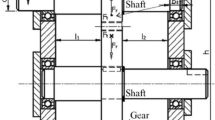Abstract
This paper presents a genetic algorithm-based approach for automatic functional design of mechanical systems. The proposed method automatically finds a set of optimal or near-optimal design solutions with respect to desired functional requirements stored in a pre-built device database. Although, typically, the design solution space of a given mechanical system is very large, the proposed strategy can generate high-quality design solutions in a timely manner. The method considers life cycle cost (LCC) factors as one of the design optimization criteria, since LCC factors have an important impact on product competency in the current market. Fuzzy logic is used to transform linguistic design requirements into numerical values. A case study is presented to illustrate the operation of the genetic algorithm-based functional design method and the efficiency of the method for optimizing the final design.
Similar content being viewed by others
References
Tor S, Britton G, Zhang W, Deng Y (2002) Guiding functional design of mechanical products through rule-based causal behavioral reasoning. Int J Prod Res 40(3):667–682
Tor S, Lee S, Lye S, Chung Y (2000) Design automation of two-stage collapsible core using design prototype. Int J Comput Integr Manuf 13(1):31–39
Arpaia P, Betta G, Langella A, Vanacore M (1995) Expert system for the optimum design of measurement systems. IEEE Proceedings on Science, Measurement and Technology 142:330–336
Li C, Tan S, Chan K (1996) A qualitative and heuristic approach to the conceptual design of mechanisms. Eng Appl Artif Intell 9(1):17–31
Gorti S, Gupta A, Kim J, Sriram R, Wong A (1998) An object-oriented representation for product and design process. Comput Aided Des 30(7):489–501
Zhang W, Tor S, Britton G (2002) A heuristic state–space approach to the functional design of mechanical systems. Int J Adv Manuf Technol 19:235–244
Quagliarella D (ed) (1998) Genetic algorithms and evolution strategies in engineering and computer science: recent advances and industrial applications. Wiley, New York
Smith S, Smith G, Liao X (2001) Automatic stable assembly sequence generation and evaluation. SME J Manuf Syst 20(4):225–235
Jang D, Kuo C (1997) Geometric parameter optimization for optimum stress in a twist drill using FEM, DOE, and genetic algorithm. NAMRI/SME XXV, Lincoln, NE, paper no. MR97-182
Chung J, Byon S, Kim H, Hwang S (2000) Process optimal design in metal forming by double-objective genetic algorithm. NAMRI/SME XXVIII, Lexington, KY, paper no. MF00-180
Chen S, Hwang C (1996) Fuzzy multiple attribute decision making. Lecture Notes in Economics and Mathematical Systems 375:466–482
Pahl G, Beitz W (1988) In: Wallace K (ed) Engineering design – a systematic approach. Springer, Berlin Heidelberg New York
Author information
Authors and Affiliations
Corresponding author
Rights and permissions
About this article
Cite this article
Shen, Z., Smith, S. Optimizing the functional design and life cycle cost of mechanical systems using genetic algorithms. Int J Adv Manuf Technol 27, 1051–1057 (2006). https://doi.org/10.1007/s00170-004-2315-0
Received:
Accepted:
Published:
Issue Date:
DOI: https://doi.org/10.1007/s00170-004-2315-0




